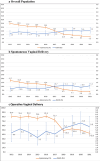Evolution of Episiotomy Incidence and Obstetric Anal Sphincter Injury Over 10 Years: A Mixed-Methods Study
- PMID: 39529171
- PMCID: PMC11794053
- DOI: 10.1111/1471-0528.17999
Evolution of Episiotomy Incidence and Obstetric Anal Sphincter Injury Over 10 Years: A Mixed-Methods Study
Abstract
Objective: To assess the association between the decrease in the use of episiotomy and the incidence of obstetric anal sphincter injuries (OASIS) over a 10-year period and understand their reasons by interviewing obstetricians and midwives.
Design: Mixed-methods study.
Setting: A tertiary university public maternity hospital, Paris, France.
Population: All patients who delivered vaginally between January 2012 and December 2021 in the maternity hospital and 20 interviews with obstetrician-gynaecologists and midwives.
Methods: Quantitative data analysis using a multivariate logistic regression model, stratifying on the mode of delivery. Semi-structured interview with 20 obstetricians and midwives, with an interview guide.
Main outcome measures: Obstetric anal sphincter injuries.
Results: The quantitative study of 37 942 women (16.1% of whom had an episiotomy and 1.4% OASIS) shows that, the incidence of episiotomy decreased from 25% to 7.6% over this 10-year period. Allow on the known risk factors for OASIS, we demonstrate that its incidence rose (adjusted odds ratio 1.35, 95% confidence interval 1.09-1.67) for the years in which the episiotomy incidence fell below 10% for the overall population. The interviews showed professionals' apparent awareness that the decreased incidence in episiotomy (achieved by changes in departmental policy, redefining its benefit/risk balance and acquiring new skills to manage the expulsion phase) could lead to an increased incidence of OASIS.
Conclusions: Decreasing the episiotomy incidence appears to be associated with a rising incidence of OASIS. The optimal incidence of episiotomy remains controversial in the literature and among professionals.
Keywords: OASIS; episiotomy; mixed‐methods; operative vaginal delivery; spontaneous vaginal delivery.
© 2024 The Author(s). BJOG: An International Journal of Obstetrics and Gynaecology published by John Wiley & Sons Ltd.
Conflict of interest statement
The authors declare no conflicts of interest.
Figures
References
-
- Blondel B., Alexander S., Bjarnadóttir R. I., et al., “Variations in Rates of Severe Perineal Tears and Episiotomies in 20 European Countries: A Study Based on Routine National Data in Euro‐Peristat Project,” Acta Obstetricia et Gynecologica Scandinavica 95, no. 7 (2016): 746–754. - PubMed
-
- Le Ray C., Lelong N., Cinelli H., Blondel B., and Collaborators–Members of the ENP2021 Study Group , “Results of the 2021 French National Perinatal Survey and Trends in Perinatal Health in Metropolitan France Since 1995,” Journal of Gynecology Obstetrics and Human Reproduction 51, no. 10 (2022): 102509. - PubMed
-
- Blondel B., Coulm B., Bonnet C., Goffinet F., Le Ray C., and National Coordination Group of the National Perinatal Surveys , “Trends in Perinatal Health in Metropolitan France From 1995 to 2016: Results From the French National Perinatal Surveys,” Journal of Gynecology Obstetrics and Human Reproduction 46, no. 10 (2017): 701–713. - PubMed
-
- World Health Organization , WHO Recommendations: Intrapartum Care for a Positive Childbirth Experience (Geneva: World Health Organization, 2018). - PubMed
MeSH terms
LinkOut - more resources
Full Text Sources
Medical


